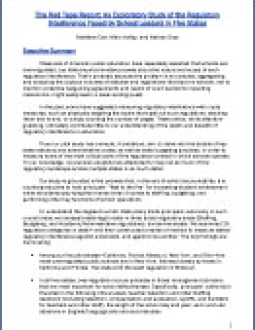Observers of American public education have repeatedly asserted that schools are over-regulated, but little empirical evidence exists about the nature and scope of such regulatory interference. That's probably because the problem is so complex; aggregating and analyzing the copious volumes of statutes and regulations that bear on schools, not to mention collective bargaining agreements and reams of court decisions impacting classrooms, might easily seem a never-ending quest.
In the past, some have suggested measuring regulatory interference with crude measures, such as physically weighing the books that spell out such regulations, stacking them end to end, or simply counting the number of pages. These antics, while attention-grabbing, ultimately contribute little to our understanding of the depth and breadth of regulatory interference in education.
Thus our pilot study has a simple, if ambitious, aim: to delve into the details of key state statutory and administrative codes, as well as state budgeting practices, in order to measure some of the most critical parts of the regulatory context in which schools operate. To our knowledge, no previous analysis has attempted to map out as much of the regulatory landscape across multiple states in as much detail.
Our study is grounded in the premise that, in this era of school accountability, it is counterproductive to hold principals' "feet to the fire" for increasing student achievement while simultaneously tying their hands when it comes to staffing, budgeting, and performing other key functions of school operations.
To understand the degree to which state policy limits principals' autonomy in such crucial areas, we analyzed state legal codes in three broad regulatory areas (Staffing, Budgeting, and Academic/Administrative regulations), across five states. We examined 26 regulatory categories in detail-and then constructed a series of metrics to measure states' regulatory interference against a standard, and against one another. The key findings are illuminating:
- Among our five pilot states-California, Florida, Missouri, New York, and Ohio-the most over-regulated public schools are in New York, followed closely by those in California and Florida. The state with the least regulation is Missouri.
- In all five states, over-regulation occurs precisely in those management domains that are most important for school effectiveness. Specifically, principals' authority is thwarted in the following critical areas: teacher selection and other staffing decisions (including retention, compensation and evaluation, layoffs, and transfers for teachers and other staff); the length of the school day and year; and curricular decisions in English/language arts and social studies.
We plan to expand our examination of state regulatory interference to include all 50 states and hope as well to devise informative comparisons of district-operated and charter schools with regard to state regulation. We want to refine and strengthen our methods and metrics to capture what is most important and relevant in measuring state regulatory interference.



